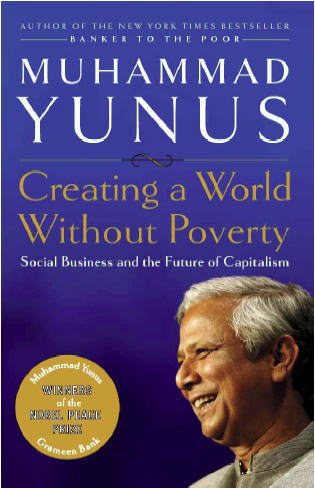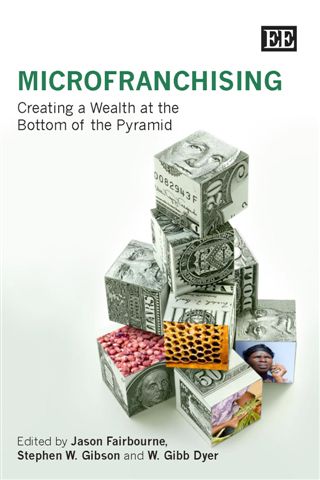
Starting with an update on microfinance, it covers other innovative market-oriented models such as base of the pyramid (BOP) businesses, social enterprises and microfranchises. These models together with microfinance are improving the lives of the 4 billion people living at the BOP. The last section covers in detail a remarkable example in this area, Scojo Foundation. Scojo is developing the market for affordable reading glasses at the BOP through microfranchising.The book provides the author’s insights on 1) how the business (for-profit) and social (non-profit) worlds have been converging, setting the stage for these new models to emerge, 2) how these models, the people behind them, and the advent of Web 2.0, are creating a strong and positive movement towards a more responsible, sustainable and kinder world and 3) how all of us could make a difference.The book has been published in German language by rueffer and rub with the title >Kleiner Einsatz Grosse Wirkung. (Small input, big impact – thus,the red chilis of the cover) This book illustrates a giga trend, the powerful movement of making the world a better place.
Category Archives: MicroFranchising
2008 Skoll Forum Highlights
The 5th Skoll World Forum for Social Entrepreneurship took place last week in Oxford. This powerful, inspiring forum led by Jeff Skoll and Sally Osberg celebrates and connects social entrepreneurs to the world and is making “social entrepreneurship” known to governments as well as businesses. This year’s highlights were the speeches of Lord Anthony Giddens (climate change: opening plenary) former President Jimmy Carter (keynote: Skoll Awards Ceremony) and Paul Farmer and Al Gore (both in the closing plenary). There were 11 Skoll Awards given out this year and Kiva (Matt Flannery and Permal Shah) was one of them. This was the second year in the row that I attended Skoll Forum and it is an awesome experience to be 3 days in a place where you see over 700 people trying to make a world a better place. One of the ventures that I was very impressed about is E+Co which empowers local enterprises in developing countries by providing business services and financing so that these enterprises can deliver clean and affordable energy to households, businesses and communities. There are several sessions that are covered by video and are all highly recommended.
Book:Creating a World Without Poverty: Social Business and the Future of Capitalism by Yunus Muhammad
 Muhammad Yunus, Nobel Peace Price winner, in his continuing fight to make poverty history promotes a new type of enterprise which has as its objective to make a difference. These social business enterprises will be self sustainable, in his words “no loss, no dividend enterprises”. He refers to two types of such enterprises one having investors like the latest joint venture between Grameen and Danone, an enterprise providing fortified yoghurt to malnourished children. Investors will get their capital back, but, profits will be injected back to the company to continue to achieve its objective. The second type of social business enterprise is a for-profit model but owned by the poor such as Grameen Bank.This book goes in depth explaining his “Next Big Idea” social businesses and also present some ideas on how corporations and individuals can take part in achieving a “world without poverty”. It is inspirational and of course uplifting. Highly recommended. Past related entry on this topic, “Muhammad Yunus promotes social businesses”http://www.microfinance.ws/microfinance/2006/12/
Muhammad Yunus, Nobel Peace Price winner, in his continuing fight to make poverty history promotes a new type of enterprise which has as its objective to make a difference. These social business enterprises will be self sustainable, in his words “no loss, no dividend enterprises”. He refers to two types of such enterprises one having investors like the latest joint venture between Grameen and Danone, an enterprise providing fortified yoghurt to malnourished children. Investors will get their capital back, but, profits will be injected back to the company to continue to achieve its objective. The second type of social business enterprise is a for-profit model but owned by the poor such as Grameen Bank.This book goes in depth explaining his “Next Big Idea” social businesses and also present some ideas on how corporations and individuals can take part in achieving a “world without poverty”. It is inspirational and of course uplifting. Highly recommended. Past related entry on this topic, “Muhammad Yunus promotes social businesses”http://www.microfinance.ws/microfinance/2006/12/
Topics for 2008: Mobile Banking at the BOP
An exciting area of growth is mobile banking as it is accelerating the outreach of financial services at the BOP. The increasing use and diffusion rate of mobile telephony in developing countries is creating low cost alternatives for people to make deposits, remittances and payments. Smart Money and Globe’s G-Cash in the Philippines, Wizzit in South Africa and M-Pesa in Kenya are some of the innovative mobile transaction systems. Africa has witnessed a spectacular growth in mobile phone subscriptions from 15.3mn in 2000 to 198mn in 2006. The penetration rate in this period soared from 1.97% in 2000 to 21.48% in 2006! (Penetration rate of fixed lines in the same period went from 2.48% to 3.09%). CGAP is covering this area with a slightly broader scope. They have published very interesting notes on “branchless banking” which they define as “the delivery of financial services outside conventional bank branches using information and communications technologies and non-bank retail agents (merchants, supermarkets, post offices)”. The notes published so far cover India, Kenya and Pakistan. Mobile banking/branchless banking is a hot topic for 2008.
The book “MicroFranchising”
 MICROFRANCHISING: Creating Wealth at the Bottom of the Pyramid, the first major publication on this subject, is now available. (Edward Elgar Publishing). This edited volume comprising 13 chapters and 18 authors introduces the concept of microfranchising and discusses how this business model can be effectively used for poverty alleviation. Different models of microfranchising are reviewed and specific case studies are highlighted to show how it has worked and is working in different parts of the world. Also the advantages as well as potential problems and pitfalls of microfranchising are discussed. My contribution was on the subject of “Microfranchise Funding” (Chapter 12).
MICROFRANCHISING: Creating Wealth at the Bottom of the Pyramid, the first major publication on this subject, is now available. (Edward Elgar Publishing). This edited volume comprising 13 chapters and 18 authors introduces the concept of microfranchising and discusses how this business model can be effectively used for poverty alleviation. Different models of microfranchising are reviewed and specific case studies are highlighted to show how it has worked and is working in different parts of the world. Also the advantages as well as potential problems and pitfalls of microfranchising are discussed. My contribution was on the subject of “Microfranchise Funding” (Chapter 12).
If there is one thing I could hope for is that the price for this book would be a bit lower so more people can afford to buy it and read it.
“The Next 4 Billion” BOP market report by WRI
The Next 4 Billion: Market Size and Business Strategy at the Base of the Pyramid is a timely and valuable contribution by the team of WRI (Allen L. Hammond, William J. Kramer, Robert S. Katz, Julia T. Tran, Courtland Walker). This reports gives a detailed economic portrait of the BOP based on recorded incomes and expenditures and an overview of sector-specific business strategies from successful enterprises operating in the BOP markets. It is full of data and information that is needed for the private sector which is currently increasing its engagement to this large segment.
The Converging Worlds: Social and Business
The business (corporate sector) and the social worlds are converging. We could call this a megatrend and it continues to gain momentum. One has seen this through microfinance where an effective development tool initially created in the social/NGO/NPO world have given birth to numerous microfinance institutions that have become sustainable and profitable. Microfinance now attracts funding/investment from both capital markets (commercial banks, asset managers, private investors) and foundations. Social entrepreneurs are also another major force behind this and no doubt that Microfranchising also links these two worlds.
One can also see it through the new partnerships between players of these two worlds especially as the multinational corporations and their executives team up with social activists and NGOs to market products to the 4 billion people at the base of the pyramid (BOP). C.K. Prahald, one of the leading advocates of BOP opportunities, has recently co-authored with Jeb Brugmann, a very interesting article in the February Harvard Business Review titled Cocreating Business’s New Social Compact. It is an excellent read (even if you have to pay for the copy to download) for those who are interested in these new partnerships. Many examples are cited including British Petroleum, Healthstore Foundation, and ICICI.
OneRoof, an innovative for-profit social enterprise
OneRoof, a social enterprise with a double bottom line has opened this year 18 stores in Mexico and India that deliver essential services to the rural poor. These stores are the pilot stores for the franchise model that OneRoof plans to launch starting from next year.
OneRoof’s is testing a unique delivery platform that provides people in rural communities access to nine essential services that taken together can help move people out of poverty. The nine essential services are: information and communication technologies (ICT), financial services (microfinance), education, energy, health, clean water, sanitation, agricultural technologies, and employment generation. The typical store starts by offering the central service, ICT, like an internet café and over time they expand on other services depending on the local demand and linkages formed by OneRoof with partners. An innovative for-profit social enterprise which is due to scale up through franchising!
Scojo: providing vision through entrepreneurship
One of the most impressive microfranchising businesses that I have encountered is managed by Scojo Foundation. There are 1.6bn people living in the developing world that need reading glasses, but only 5% have access to affordable options. Scojo is broadening the global access to reading glasses by training and equipping local entrepreneurs (they become the microfranchisees referred as vision entrepreneurs) so they can establish a new business of selling glasses.Scojo has already expanded their programs to 4 countries (El Salvador, Guatemala, India and Bangladesh) and the 5th country Mexico is about to start. One of the greatest achievements of Scojo is that they have been able to scale up by working through effective partnerships. The partnership with the microfinance institution BRAC in Bangladesh is a prime example. BRAC has more than 5 million clients. Scojo has started to train 60 of BRAC’s community health workers.. this is scaling up. I just visited Scojo’s operations in El Salvador and Guatemala as I intend to write a book on this subject.
Realizing Property Rights

“Realizing Property Rights” (Swiss Human Rights Book Volume 1) a book edited by Hernando de Soto and Francis Cheneval is now out (Publisher: Rüffer & Rub). This book deals with property rights as human rights seen from different cultural and historical contexts and from different thematic angles. It has been an honour for me to have been able to contribute a chapter for this book titled “Microcredit, MicroFranchising and Women Entrepreneurs”
